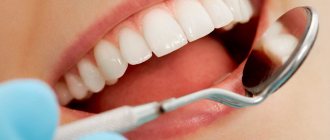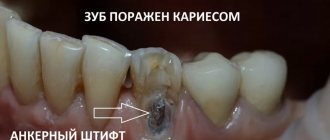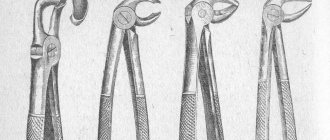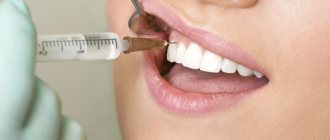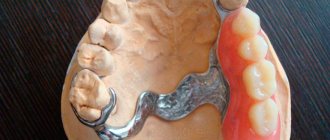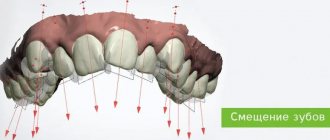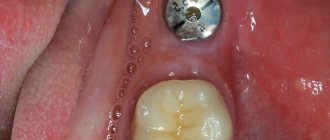One of the most common methods of dental restoration is the installation of crowns. This process is called prosthetics, and with its help it is possible to restore not only the functions of the dentition, but also restore their former aesthetics. After installing crowns, patients often forget to check with a specialist for information about their service life, because they have a certain resource. It depends on various factors, and therefore it is very important to thoroughly understand the question of when dental crowns should be replaced, as well as for what. After all, not only comfortable eating, but also the general condition of the oral cavity depends on this.
Dental crowns in our clinic
Specialists from the Beryozka clinic will help you place strong dental crowns based on an individual impression. Our doctors work according to the most modern treatment protocols, which ensures maximum similarity of the artificial crown with the real one. High-tech materials ensure long-lasting wear even with intensive use of the crown.
Making a crown based on an individual impression ensures the most comfortable use. And budget prices allow you to restore the beauty and functionality of the jaws to a person with any income.
Free consultation!
You can get acquainted with the specialists of the Beryozka clinic and decide on the need to install a crown at a free consultation. Our doctors are confident that the patient, once in their hands, will definitely return for treatment. This is facilitated by the beautiful and comfortable environment in the offices, friendly and polite staff, as well as the high professionalism of the dentists.
What is a dental crown
The visible part of a natural tooth is the crown. It is most often destroyed due to caries, trauma or the process of demineralization. It can be restored with an artificial prosthesis - a dental crown. It can be temporary - for the period of treatment, or permanent - for every day. In some cases, crowns are used to correct the shape of implants when they are damaged.
Self extraction
Self-extraction is not recommended. Using tools that are not intended for this purpose (pliers or wire cutters) can lead to injury to the mucous membranes and breakage of the tooth stump.
But there are cases when the microprosthesis has completely separated from the tooth and is loose, or even broken into pieces, which creates a danger of swallowing it along with food. In this case, you need to remove it and visit a doctor as soon as possible to install a new microprosthesis.
In the video, the dentist will tell you what harm old crowns cause to your health.
Contraindications
Like any medical procedure, the installation of crowns has contraindications. Cases in which the procedure is not performed:
- advanced periodontitis;
- bruxism - teeth grinding;
- fragile enamel;
- teeth are small and poorly positioned;
- pathological bite, when the incisors overlap one another.
Sometimes the age of the patient may be a contraindication to installing a crown made of a certain material. Then he is offered another way to restore the integrity of the dentition.
What are they: materials
Crowns are made from different materials: some are more durable, others are only suitable as a temporary measure. Their cost, complexity of manufacturing and installation also depend on this.
Metal ceramics
The product has a metal frame and is covered with ceramics on top.
| Pros: | Minuses: |
| High strength. | Contraindicated for people under 18 years of age. |
| Aesthetics. | Not suitable for gum recession. |
Metal-ceramic crowns are suitable for installation only in adult patients.
Metal composite
The crown frame is made of an alloy of chromium and cobalt. From above it is covered with a photopolymer composite: while it is soft, it is given a shape, after which it is fixed with UV rays.
| Pros: | Minuses: |
| High strength. | Coloring from products with pigment. |
| Thin and invisible edges. |
People with metal-composite crowns need to follow a diet to prevent artificial teeth from changing color. It is not recommended to consume drinks with dyes and foods with a high pigment content.
Golden
The oldest material for making crowns is gold.
| Pros: | Minuses: |
| Hypoallergenic. | Lack of aesthetics. |
| They do not damage neighboring healthy teeth. | Rapid abrasion due to the softness of the metal. |
It is best to install gold crowns on the back teeth, where they will be almost invisible.
Zirconium dioxide
Modern material for crowns is zirconium dioxide. It is durable, aesthetic, does not cause allergies and lasts a long time. But it has a fairly high cost, so it’s not suitable for everyone’s budget.
Metal-free
Modern synthetic materials can completely replace metal in the composition of the crown. They are no less durable, and look as close as possible to natural teeth.
Ceramic
The best way to choose the color of a crown is when it is made of ceramic. They do not look artificial, as they are quite transparent.
They are great for replacing incisors. But for chewing teeth, ceramic crowns are too fragile and cannot withstand such a load.
Porcelain
Porcelain crowns are not so popular, but are gradually becoming more and more in demand. They are easily and firmly fixed, which reduces the risk of loosening. Porcelain products last a long time, do not deteriorate due to temperature changes and are not stained by food. In this case, the crown can be made in an anatomical shape, repeating the relief of the tooth as accurately as possible, which ensures comfortable wearing. They look very aesthetically pleasing and are also hypoallergenic.
One of the disadvantages is their loose fit to the tooth, which can cause cervical caries. Crowns are quite fragile and can destroy adjacent healthy teeth. The product is not suitable for patients with thin enamel. In addition, the cost of such crowns is quite high, which is not affordable for everyone.
Combined
By combining several materials, it is possible to create crowns that combine their best properties. The product is suitable for use on front and back teeth: they look aesthetically pleasing and can withstand chewing loads. But such crowns are short-lived because they quickly wear out and sometimes become deformed. But their installation does not cause a blow to the budget.
Plastic
Plastic crowns are used as a temporary measure. They are manufactured on site and installed on the same day in place of the extracted or treated tooth. The cost of such crowns is low. But it is impossible to use them as permanent ones, since they cannot withstand prolonged chewing load.
Pros of ceramics
Engineers and chemists of large concerns for the production of dental materials (mostly German) are very hardworking and purposeful people. This is not a common stamp - I was convinced of this from my own experience, watching the evolution of ceramic crowns from Ivoclar Vivadent for 15 years. This is not an advertisement - this name means little to the average person, and dentists do not trust advertising. Over the years, the company has come a long way from really fragile crowns in the 2000s (the instructions said so - only for front teeth, with a bunch of contraindications) to the modern material e.Max (Imax, emphasis on the letter I), which in most cases regions is crowding out the former grandee - zirconium dioxide.
Let's list what makes Emax so remarkable:
- Strength. Allows you to make not only crowns, but also bridges. Not only for front teeth, but for any teeth. There is enough strength to spare.
- A huge selection of colors, transparency options , the possibility of individualization either by simple painting or by applying additional layers of ceramics (this is the finest work on the verge of craft and art, in some cases up to 15 layers of ceramics are used, achieving incredible naturalness).
- Possibility of manufacturing individual implant abutments. The abutment is the outer part of the implant; the crown rests on it. There are two options for their use - standard titanium abutments manufactured at the factory (there is no time for aesthetics here, the strength or complexity of the design is important) or individual abutments. If you make such an abutment from Imax material, the crown on the implant (by the way, it can also be Imax) will be more aesthetically pleasing.
- Emax has brought digital technology directly to the dental chair. Now the doctor can make crowns on his own and in one visit . The aesthetics and strength are the same, the accuracy is higher - the human factor is reduced to a minimum. This technology is called CEREC (Cerek, emphasis on the first syllable), in conjunction with modern ceramic materials, it is incredibly convenient for both the doctor and the patient.
- The crown is bonded to the tooth (dentists call this bonding) by creating a chemical bond between the ceramic, adhesive luting cement and the tooth tissue. This connection is absolutely sealed and durable.
Types of crowns
The number of missing teeth, the presence of dentures and other individual characteristics of the patient determine what type of crown is suitable for him. It is impossible to determine this in absentia, since it requires an examination by a specialist.
Bridges
Suitable for people who have lost more than one tooth. The prosthesis is made for all missing units, and its parts are connected by a metal bridge. To secure the crowns, you need healthy chewing teeth. Only complex prosthetics are performed in this way.
Implant supported crowns
If the patient has implants, the crown can be secured to them. This will prevent the destruction of healthy teeth, which can occur due to excess stress. But the method is only suitable for those who already have implants installed.
Crown for one tooth
If one tooth is destroyed, a crown can be installed only on it. This usually happens after deep caries or injuries. Before installing a crown, the condition of the periodontium, jaw and gum tissue is assessed. Sometimes additional operations are performed to build up the bone plate.
Fixation with a pin
The rarest method of prosthetics is installing a crown on a pin. It is quite traumatic and carries a risk of complications, so it is almost never used. If other methods of prosthetics are not available to the patient, the crown is installed on a pin, but this is done in several stages under the supervision of specialists at each of them.
A crown was installed. What happens to the tooth?
A protective covering is placed on a tooth to preserve it and restore its shape, appearance and functionality. However, there is a myth that teeth under crowns deteriorate faster. What happens after the structure is installed? Depending on the load, care, hygiene, and general health, changes in the condition of the oral cavity and bone tissue occur. The gum margin may gradually recede and expose the edges of the crown . In this case, the connection loses its tightness, saliva gets under the crown and gradually washes out the cement connecting it to the tooth.
Microbial flora has a destructive effect on dental tissue, and the fixation of the structure is disrupted. Wearing such a crown for a long time can actually lead to an unfavorable development of the situation and tooth loss. At the same time, the doctor, discovering the failure of the orthopedic structure, will offer an adequate replacement. If the problem is detected in a timely manner, only the crown is replaced, and the supporting teeth are preserved and serve for many more years. How can you tell when it's time to change your crowns? Here are the main signs that you should see a doctor when they appear:
- The edge of the crown is exposed . The gingival margin can rise on the upper jaw or fall on the lower jaw and expose the roots of the teeth. In this case, the development of root caries and damage to dental tissues under the crown is possible.
- The gums around the crown are inflamed . Changes in gum color, redness, swelling, and bleeding during brushing indicate that the marginal fit of the crown to the tooth is broken.
- The structure has become movable . Unstable fixation, loosening of the crown or bridge indicates decementing and loss of fastening strength. Improper load distribution can also lead to loosening of supporting teeth, so it is important to promptly reline bridge structures.
- The integrity of the coating has been compromised . Even minor chips can lead to negative consequences. Sharp edges injure the mucous membrane, the height of the bite changes, and antagonist teeth begin to experience excessive stress. A crack or chip allows salivary fluid access to the cement and then to the tooth tissue, which can cause caries under the crown.
- An unpleasant smell or taste appeared , pieces of food began to get stuck between the crowns or crowns and teeth. Such phenomena indicate a violation of fixation and the onset of a pathological process under the influence of bacteria.
Methods for making a crown
Orthodontic products can be manufactured using several methods. Each of them has its own advantages and disadvantages.
Cast products
Strong and durable crowns are made using casting. For this, a single piece of metal is used. The method is not suitable for all materials.
Stamped
More affordable, but less durable prostheses are made by stamping:
- a mold is placed into the dental anvil;
- using rubber rings a stamp is obtained;
- the crown is made using special hammers that differ in shape and size;
- The product is given its final shape using small tongs.
Such crowns last less than cast ones, but are much cheaper to produce.
How a tooth crown is made
Before starting to make the prosthesis, the size and shape of the product are determined. To do this, the patient undergoes:
- examination by a doctor;
- general and targeted x-ray diagnostics;
- 3D - visualization on a computer screen of the entire jaw and a specific tooth.
Then the doctor selects the material from which the crown will be made. It depends on which tooth needs to be replaced, the age of the patient and his financial capabilities.
To accurately manufacture the prosthesis, an impression of the jaw is taken. For this, gypsum or a similar synthetic material is used. The resulting model is sent to the laboratory.
Operational period of popular types
Depending on objective and subjective factors, the service life of artificial structures ranges from 3 to 15 years.
Objective factors include the type of material from which the structure is made, the service life of the cement or glue, the condition of the supporting tooth, and the general health of the patient. Subjective ones include the quality of manufacturing and installation of the microprosthesis, the conditions of its operation.
Material is the main factor that determines the service life of a crown. Depending on it, the patient can count on the following service periods:
- Plastic (provisional) - up to 3 years.
- Metal-plastic – up to 5 years.
- Metal from base metals - up to 10 years, from gold alloys - up to 15 years.
- All-ceramic – 7-10 years.
- Metal-ceramic - up to 10 years.
- Zirconium dioxide – 10-15 years.
Their service life is also greatly influenced by their operating conditions. The quality of oral care, food preferences, the presence or absence of bad habits, following or ignoring doctor’s recommendations can significantly increase or decrease the average service life of a microprosthesis.
Preparing for installation
A crown cannot be placed on an unprepared tooth. He must be completely healthy. If you have inflammatory diseases of the oral cavity, they need to be cured before installing a crown.
Then the teeth are ground down. It is performed under anesthesia, so the patient does not experience any discomfort. This procedure is carried out to ensure that the denture fits perfectly and no food remains get stuck under it. It also allows you to equalize the width of the neck and middle of the tooth. This way the prosthesis will be firmly fixed, which will prevent loosening.
Only 1-2 mm of enamel is removed. The depth of treatment depends on the selected crown material: metal-ceramics require more space, and ceramics are quite thin; a very thin layer is removed to install it.
In some cases, depulpation is performed. The patient is warned about its need in advance.
If the tooth is severely damaged, a core inlay is installed. It separates the internal tissues from the crown, allowing you to avoid pain while wearing it.
Upon completion of all manipulations, a temporary crown is installed on the tooth. It is made in the dentist's chair. The design protects the prepared area and restores its aesthetic appearance.
Installation process
The crown is installed in several stages. The number of visits to the doctor depends on the condition of the teeth and the chosen prosthetic method.
Laboratory stage
A cast of the patient's jaw is sent to the laboratory to create a plaster model of the jaw. After complete drying, the desired part is cut out. Using it, a wax prototype is made.
The model is fixed on the base and filled with a special mixture. It goes into the oven for 4-5 hours. The resulting mold is immediately filled with the alloy while it is hot. The future crown is left in this form until it hardens completely. The piece is then polished and sanded to achieve the perfect shape.
Removing the temporary structure
When the permanent crown is ready, the temporary structure is removed. It only takes a few minutes, after which prosthetics can be applied.
Installing a crown on a tooth
Before fixing the crown, a fitting is performed. If it is uncomfortable or the enamel color is not suitable, it is sent for revision. When the crown is perfect, it is secured with cement. The strength of the fixation must be checked after the material has hardened.
Monitoring the situation after installation
After fixing the crown, the doctor checks how correctly it is installed. To do this, an x-ray is taken. Only after his assessment can the patient go home. If you experience strange sensations, you should call your dentist to clarify your condition and the need for a second visit.
Our advantages
At the Beryozka clinic, the material for the crown and its type are selected individually. Each patient is given an approximate treatment estimate so that he can clearly see what he is paying for. A transparent work system, professionals, the latest equipment and materials ensure the ideal result of prosthetics at the Beryozka clinic. A polite attitude and the ability to quickly get an appointment are the key to pleasant emotions from visiting a dentist.
No. 8 Question and answer: Questions from patients about prosthetics and implantation
– How can you determine when it’s time to change the crown? The tooth is not bothering me yet, but I don’t remember how many years the crown has been in place!
– Only a doctor can tell you during an examination whether the crown needs to be changed or not.
For this purpose, we recommend preventive examinations every six months. The fact is that there is no exact service life of artificial crowns - there is data obtained from examinations of a large number of patients who come for appointments for prevention. These periods range from five to seven years, depending on the materials used in the manufacture of the crown, on the qualifications of the doctor and dental technician who performed the work, as well as on the load, care, daily hygiene, and bite of the patient. The need for replacement is explained by atrophy of the bone tissue of the alveolar process, which occurs with both natural teeth and crowns, which entails a change in the position of the marginal gum. As soon as the gum exposes the edge of the crown, the latter becomes not completely sealed, and salivary-gingival fluid begins to get under it. Further, the salivary-gingival fluid increasingly washes away the cement on which the crown is fixed. As a result, microbial flora begins to enter there, affecting hard tissues. The crown can remain in this condition for a long time, sometimes up to 15 years, but after it is removed, the unfavorable outcome of just such a long wearing or use of the crown invariably leads to tooth loss. Therefore, we ask patients to come regularly for preventive examinations of orthopedic structures. As soon as their failure is discovered, a replacement is proposed. This is not the loss of supporting teeth, but only the replacement of an orthopedic structure, which will again hermetically close the crown part of the tooth, which will make it possible to save it, and not go along the long path - removal, implantation, restoration with a crown. – I plan to replace my “ancient” bridge with implants, but I don’t want others to know about it.
Is it possible to cover the implants with a crown immediately after installation so that missing teeth are not visible when smiling? – It is extremely rare that when a patient wants to perform this manipulation, the doctor may refuse him. Nowadays, the technology for instant restoration of damaged crowns, bridges or natural teeth is so developed that they can always be restored in the shortest possible time. Most often this is done day after day while the patient is in the doctor's chair. This happens almost instantly: first, an impression is taken of the prosthesis that is in the mouth, then the bridge or crown is removed, then a bridge is restored from fast-hardening plastic, which can remain in the oral cavity for a short time, and then it is changed to a laboratory prosthesis and a temporary structure. Now we even insist that patients do not walk without temporary structures, since with their help the correct chewing load is restored. In the absence of temporary structures, increased load most often falls on the front teeth, which entails loss of bone tissue, exposure of roots, and ultimately weakening of teeth that were in the oral cavity under nonspecific pressure.
Pros and cons of crowns
All medical procedures have both pros and cons. Before you decide to install crowns, you should compare the pros and cons.
Advantages
The advantages of using this method of prosthetics are much greater than the disadvantages. The advantages of installing crowns include:
- preventing the destruction of pulpless teeth;
- preservation of a living tooth even with partial destruction;
- restoration of the ability to chew food normally;
- restoration of an aesthetic appearance while smiling;
- prevention of diseases of the gastrointestinal tract, which can be caused by insufficient chewing of food;
- restoration of the ability to speak clearly.
Due to the large number of advantages, the procedure has become so popular among patients.
Flaws
The procedure for installing crowns has its disadvantages. Flaws:
- the need to grind healthy parts of the tooth;
- limited period of wearing a prosthesis;
- inability to carry out the procedure with a damaged root;
- the need for regular visits to the dentist for monitoring.
The disadvantages of the procedure are offset by its advantages. Therefore, crowns remain the most popular way to restore the integrity of the dentition.



